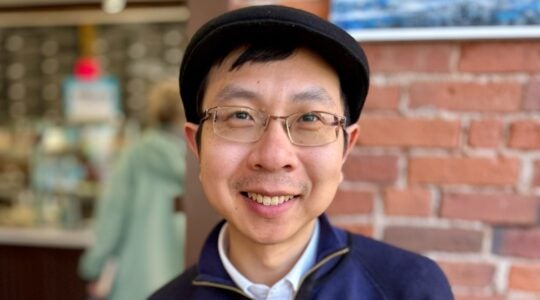Over a cup of coffee several years ago at Mossad headquarters in Tel Aviv with the director of the Israeli spy agency’s archives, Avner Avraham learned that the Mossad archives still contained the Adolf Eichmann files.
Avraham, 52, an author, public speaker and former Mossad communications specialist, was intrigued.
In high school, decades earlier, he had learned about the architect of the Final Solution and joined a high school visit to Poland, where he “saw the death camps … saw Auschwitz.” Eichmann, an SS lieutenant colonel who as director of the Gestapo department of Jewish affairs had plotted the logistics of the mass extermination of European Jewry, had found refuge in Argentina after World War II, was abducted by Mossad agents in 1961 and went on trial and was hanged in Israel in 1962. The highest-ranking Nazi war criminal still at large, a bureaucrat who had become a cog in a killing machine, Eichmann had become the public face of the 20th century’s worst genocide.
Intrigued by the archivist’s words, Avraham received permission to look at the Eichmann files. In several cardboard boxes he saw such items as a key-duplicating machine, a 35-MM Leica camera used by the Mossad agents, and the agents’ airplane tickets to Argentina — the artifacts that had played a critical part in finding Eichmann and bringing him to justice.
It was a rare find.
Most Mossad files at that time contained only documents. Eichmann’s was replete with the other objects, said Avraham, because it was the agency’s first highly visible case. No one wanted to get rid of anything. The Mossad kept everything connected with Eichmann.
The finding inspired Avraham, who studied curation at Tel Aviv University and had already organized an exhibit about Haganah activities during World War II, to put together an exhibit about Eichmann’s capture in Mossad headquarters. It was for Mossad eyes only. And for other government officials with top-level security clearance. Including Prime Minister Benjamin Netanyahu, who, after touring the exhibit, suggested that Avraham bring it to the Knesset and open it to the public.
He added to the collection other items he gathered from family members of the witness-survivors, people who served as guards at the trial, and other men and women with a connection to the proceedings.
The exhibit, which in an expanded and annotated form was on view earlier this year at museums in Cleveland and Chicago, opened Sunday, July 16, at the Museum of Jewish Heritage — A Living Memorial to the Holocaust in Battery Park City; it runs through Dec. 22, accompanied by a series of lectures and events.
“Operation Finale: The Capture & Trial of Adolf Eichmann” features 130 artifacts from the Mossad collection, all declassified for the exhibit and appearing in New York City for the first time, in addition to some artifacts and explanatory panels that add some historical context about the Holocaust and its aftermath.
The curators have also added some context to the original Israeli exhibit to make the Eichmann story more understandable to visitors from the diaspora. A dimly lit hall, some 250 steps from the entrance of the show, evokes the dark spirit of the Shoah and serves as an introduction to those dark days. Once inside the exhibit itself, a visitor sees a suitcase used by the Mossad agents, maps of the Buenos Aires neighborhood where Eichmann lived under the false name Ricardo Klement and small profiles of the 11 Mossad agents who played key roles in the Eichmann capture. There are forged documents made by the agents, surveillance photos, tickets to the Eichmann trial, an enlarged black-and-white photograph of the El Al plane that carried Eichmann to Israel, Eichmann’s handwritten letter to the president of Israel that asked for the death sentence to be waived, documents in three languages (German, Hebrew and English), and information about the
Holocaust-survivor-turned-German-prosecutor who provided crucial
information to the agents. (His story was recently told in the acclaimed film “The People Vs. Fritz Bauer.”)
It all culminates with the actual bulletproof glass booth in which Eichmann sat impassively during his trial in a courtroom set up in the Beit Ha’am community center in Jerusalem. The glass booth that inspired a Broadway play and Hollywood movie titled “The Man in the Glass Booth” in the 1970s.
Visitors to the exhibit can sit on three benches in front of the booth (images of the trial are projected on the surrounding walls, accompanied by the witnesses’ testimony and prosecutors’ dramatic statements, complete with English subtitles) and imagine themselves gazing at Eichmann. In that setting a visitor is not in a museum, but among the major actors of post-Holocaust Jewish history, part of the legal proceedings that captured the world’s imagination.
The exhibit — jointly produced by the Mossad, Tel Aviv’s Beit Hatfusot and Cleveland’s Maltz Museum of Jewish Heritage — brings to life the first major war crimes trial of a single individual. “Operation Finale” was the Mossad’s code name for Eichmann’s capture.
The trial, said Yitzchak Mais, the exhibit’s Bronx-born consulting curator who has lived in Israel since 1973, exerted more of an emotional impact on the general public than had the Nuremberg Trials of 1945-46 because it centered around one person instead of a group in a docket, because it dealt directly with the killing of European Jewry instead of general “crimes against humanity,” and because media coverage was more immediate — the trial was carried live on Israeli television.
The “cloak and dagger” exhibit, Mais said, answers several questions: “Who was Eichmann? What did he do? Why was he in Argentina? Who else [fellow former Nazis] was there? Why did Israel decide to go and capture Eichmann?”
The Eichmann trial, said Mais, changed the perception of Holocaust survivors “from victims into heroes” who emerged as functioning human beings, and spurred the creation of university-level Holocaust studies.
The exhibit, 55 years after the Eichmann trial, is remedial history for members of younger generations, especially outside of Israel, for whom Eichmann is ancient history, Avraham said in an interview with the Jewish Week.
“In Israel, everyone knows [the name of] Eichmann,” the monster, the conscience-less bureaucrat, the only person put to death by the Israeli legal system, Avraham said.
Outside of Israel, fewer know his name.
As the generation of survivors and liberators dies, tactile reminders become necessary. Actual artifacts that showed how the Mossad, which had not yet achieved its international reputation as a highly efficient, thoroughly professional, sometimes ruthless intelligence agency, succeeded against the odds in tracking down its elusive quarry.
Avraham cast the exhibit as an adventure tale. One whose ending is known from the start. People come to see a “spy story,” and then “see the Holocaust story,” he said.
Avraham, who is at work on a book about Eichmann, based on the Mossad collection, and has an unspecified connection with an MGM movie about Eichmann, also to be titled “Operation Finale,” called his interest in educating about the Holocaust “a mission. It’s the most important issue for the Jewish people. If you say ‘Never Again,’ you have to say what happened.”
Is he succeeding?
Avraham said he has met with people who toured the exhibit in Cleveland and Chicago. “Most of them cry. They hug me. They kiss me.”
They thank him for creating the exhibit. “Then,” he said, “I know I am successful.”
“Operation Finale: The Capture & Trial of Adolf Eichmann” runs through Dec. 22 at the Museum of Jewish Heritage in Battery Park City, mjhnyc.org.
The New York Jewish Week brings you the stories behind the headlines, keeping you connected to Jewish life in New York. Help sustain the reporting you trust by donating today.




